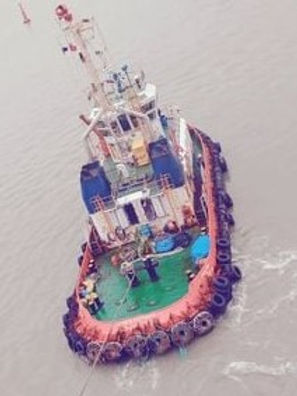Types of Tugs
Below are the types of tugs most widely used:-
-
Conventional Tug
-
Tractor tug
-
ASD (Azimuth Stern Drive) tug
-
Rotor tug
-
Voith Schnider Tug
Conventional tugs
Tugs are fitted with fixed propellers, single or twin screw (left or right-handed) and single or twin rudder. One can consider them as simple small twin screw vessel.
-
They are mostly used in harbors for towing duties or pull back operation (at Centre lead aft).
-
Towing hook/winch is placed aft of amidship.
-
Due to less maneuverability as compared to Tractor or ASD tugs, they are not preferred for assisting vessels in berthing/unberthing, especially in tight harbors.
-
They have good sea-keeping ability hence often used for long distance towing.
-
Bollard pull in astern operation may reduced by up to 50 percent of forward direction.
-
They have higher risk of girding.

Azimuth sterndrive tugs( ASD)
Usually 2 fixed pitch propeller with variable RPM engine, mounted onto 360 deg rotatable Azimuth fitted on aft part of tug. May or may not have Bow/tunnel thrusters.
General Characteristics of ASD tugs are:
-
They have low relative draught as compared to tractor tugs of similar bollard pull
-
Good steering and maneuvering characteristics.
-
Towing point is usually forward, they are very good for push/pull tug with almost similar power in both ahead/astern pull. Hence can be used for assisting berthing/unberthing of vessels in fwd/aft/side tugs.

-
Under water hull is specially designed to keep low VCG and also at times Skeg may be built to improve dynamic stability of the tug.
-
Risk of girting/girding when towing over the stern. ASD tugs can side steep at maximum 2-2.5 kts, if speed of vessel is higher, they will have difficulty in remaining perpendicular hence will not be able to push or pull at 90 deg. Any sudden force on towline when tug is not able to straighten itself may lead to girding.
-
Additional training is required for tug Masters to effectively use ASD tugs.


Image- Azimuth propulsion unit of ASD tug mounted aft
Image- Azimuth propulsion Inner gear arrangement
Tractor tugs
Usually 2 fixed pitch propeller with variable RPM engine, mounted onto 360 deg rotatable Azimuth fitted midship or slight fwd of midship.
The propulsion units are placed far ahead of the towing point, close to the pivot point thereby producing a large turning momentum. This potentially gives a poor steering performance, which is overcome by fitting a large centerline skeg.
Their general characteristics are:
-
They are higly maneuverable with almost full power available in any direction.
-
Less risk of girting/girding as they can do higher speeds in sideways stepping and also turn and align much faster.

-
Maneuverability is reduced if towing from forward at higher speeds.
-
Less directional stability, particularly in open waters.
-
Due to propeller fitted at midship exceeding the main hull, they have relatively deeper draft therefore increased risk of bottom damage from grounding.
-
tug master need additional training to make best use of this type of tug.
The Rotor tug
The rotor tug is an extension of tractor tug. It uses a propulsion configuration consisting of three azimuth propellers placed in a triangular configuration, sometimes called a triple Z drive. Two units are placed forward like tractor tug and one astern on the centerline of the tug.
Rotor tug characteristics include:
-
Better maneuverability, useful in confined spaces.
-
Good towing performance over the stern and bow; 100% bollard pull ahead and astern; 65% of bollard pull athwart ships.
-
Better able to handle in case of single engine failure.
-
tug master need additional training to make best use of this improved design.
The Voith Schnider tug
(https://en.wikipedia.org/wiki/Voith_Schneider_Propeller)
The Voith Schnider tug are similar to tractor tug except that instead of propeller they use Cycloid rotor.
In this arrangement usually blade are fitted below a Horizontal rotating disc. Each blade can be rotated to change angle of attack with water. A programmed movement of blade direction is done so that each is facing at an angle to create net thrust in required direction.
The advantage of Voith Scnhider are they much more maneuverable, less risk of propeller fouling, much lesser vibrations. However initial cost is higher due to complex machinery design. Also require specialized training for tug Masters.

Working principle of Voith Schnider propulsion
Image credit Wikipedia
Now we will move to next part of topic i.e. Safe and effective use of tugs (Click on this link)


